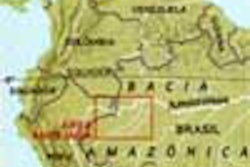The imaging equipment being brought on the Imagem do Javari Expedition shows how recent technological advances are enabling clinicians to deliver imaging services to remote corners of the globe that were inaccessible just a few years ago. From portable ultrasound to satellite teleradiology uplinks, the expedition will serve as a proving ground to demonstrate digital technology's potential to improve patient care in underserved areas.
The expedition has turned its boat, the Kukaha, into a floating imaging center, stocked with image acquisition equipment as well as a small reading center for reviewing images. The Kukaha's radiology armamentarium will include two portable compact ultrasound machines (LogiqBook, GE Healthcare, Waukesha, WI), a portable x-ray unit (Limex, Brazil), and two computed radiography readers (DirectView CR 500, Eastman Kodak Health Imaging, Rochester, NY). The equipment will be powered by a generator on board the boat.
Most patients will be brought to the boat for imaging exams, and the portable ultrasound units can be taken into the field as well. The portable x-ray unit will include a CR cassette that temporarily stores images using storage-phosphor digital technology. The cassettes will be read out on the CR 500 unit to produce digital images that expedition radiologist Dr. Sergio Brincas can review on a 3-megapixel monitor.
Brincas' workstation can serve as either a diagnostic reading station or as a Web client capable of sending images via satellite link to Brincas' home facility, Clínica Imagem in Florianópolis, Brazil. Radiologists will be on hand at Clínica Imagem to consult with Brincas on particularly difficult cases.
The system on the boat will have archiving capacity to handle about three months' worth of imaging studies. In addition, Brincas will have access to Kodak's CD Direct technology, which enables clinicians to burn medical images to CDs that have their own internal reader for viewing DICOM files, the radiology industry's format for storing digital medical images. The built-in viewer means other radiologists and referring physicians don't need specialized viewing software to review images, according to Mike Fiske, director of marketing for Kodak's Healthcare Information Systems unit.
All of the technologies being used on the expedition are relatively new to radiology. The first commercial computed radiography system was introduced in 1983, but the technology has taken hold primarily in the last 10 years as an inexpensive way to digitize radiography studies for incorporation into a digital image management network, or PACS (picture archive and communication system).
Likewise, compact ultrasound systems about the size of small laptop computers were first introduced in the late 1990s as a cost-effective way to bring ultrasound technology directly to patients. The scanners are finding favor as a sort of electronic stethoscope that excels at triaging and screening patients quickly, and the systems are being used in primary care environments at remote locations around the world.
The digital imaging environment that Brincas will use is also a relatively recent phenomenon. Hospitals have begun transitioning to PACS in the last decade in an effort to take advantage of the operational efficiencies offered by digital technology. One huge advantage of PACS is that images no longer have to be reviewed in the same location where they are acquired.
This has major implications for remote regions like the Amazon that often don't have regular access to high-quality healthcare. Thanks to PACS, images can be acquired in the field with digital technologies, and then sent to advanced facilities where they are interpreted by experienced radiologists.
As an added benefit, the entire Amazon operation is filmless, an important consideration in the pristine environment of the jungle. Older x-ray technologies relied on chemical developing to create the films that radiologists read; these technologies produced a number of chemicals as a byproduct of the film-developing process, and Imagem do Javari was eager to steer clear of polluting technologies.
For their part, Kodak executives look forward to showing that if digital radiology equipment can work in the extreme environment of the Amazon jungle, it can work almost anywhere else around the world.
"We talk about the ability to do diagnosis in a lot of extreme situations and do it in a high-quality way. This demonstrates the real limits to that to prove that it is the case," said Jeff Markin, vice president and general manager of Kodak's Healthcare Information Systems division. "It really does demonstrate that you can go into the most technologically challenging, remote areas and really facilitate leading-edge healthcare."
By Brian CaseyAuntMinnie.com staff writer
April 2, 2004
Copyright © 2004 AuntMinnie.com



















